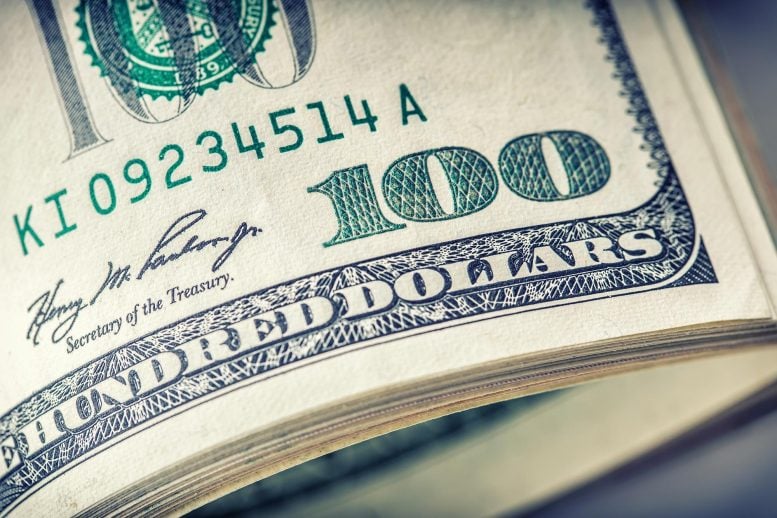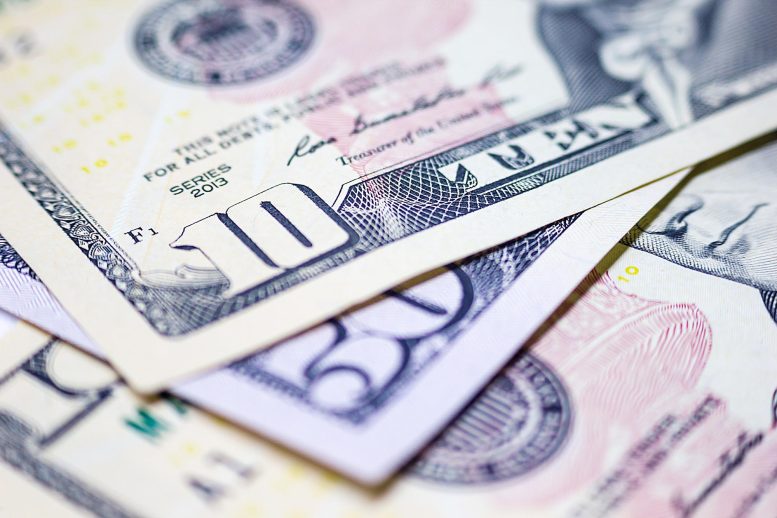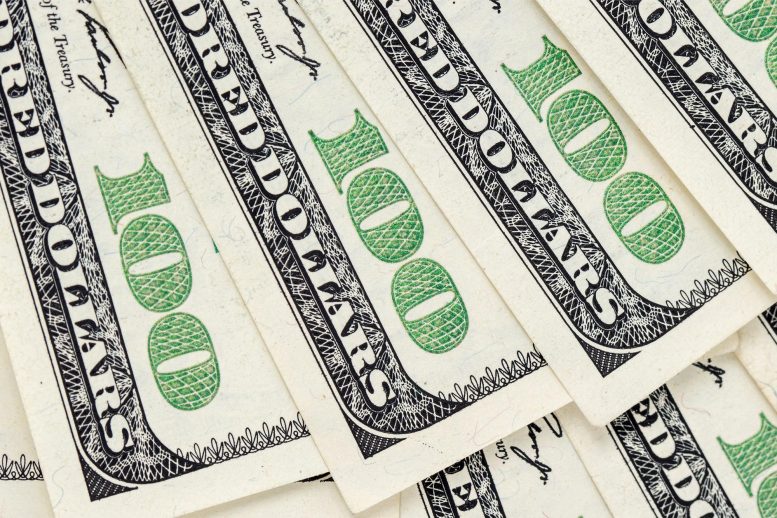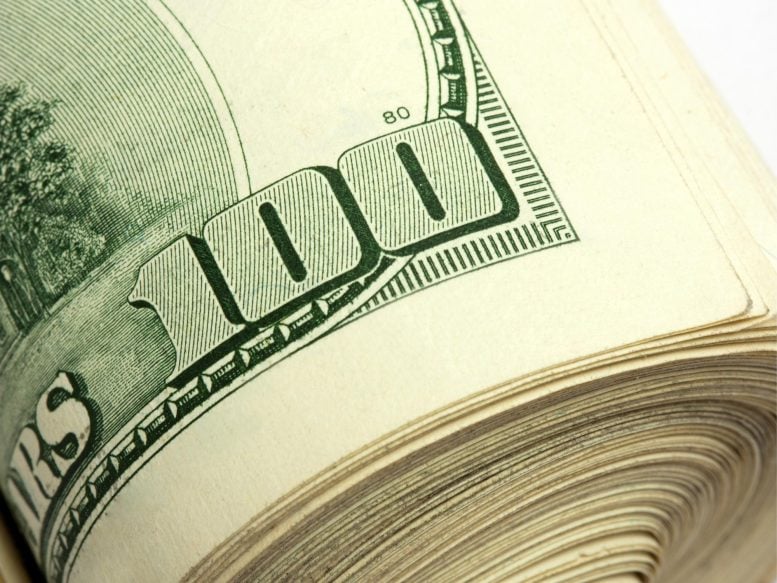
The Denomination Effect explains why you’re more likely to hang on to a $100 bill than five $20s.
Picture this: you’re going to the office and you stop at your regular coffee shop on the way. You pick up your usual large mocha and you eye the ham and cheese paninis hungrily. Breakfast did not fill you up as much as it usually does, and you’re feeling peckish. You look in your wallet and see that you have two $5 bills. You buy the coffee and the sandwich. Now picture this: same scenario, but when you look in your wallet you see a $5 bill and a $50 bill. Chances are, this time you’ll skip the panini. Why? Because of the denomination effect.
What is the denomination effect?
The denomination effect describes our greater willingness to spend money if we use smaller denominations; even though a $100 note has the same value as ten $10 notes, we are much more likely to spend the $10 notes before we even think of touching the $100.
The seminal study
The term “denomination effect” was coined by marketing professors Priya Raghubir and Joydeep Srivastava in their 2009 research paper[1] on spending behavior. In their first experiment, undergraduate students from two American universities were given a small amount of money — ostensibly as a thank you for taking part in an experimental session — and told that they could either keep the money or spend it on candy. One set of students was given four 25¢ coins and another was given a $1 bill. Sixty-three percent of the participants with the four quarters decided to purchase candy, while only 26 percent of those given the $1 bill spent any money. The researchers concluded that people are more inclined to spend smaller-denomination money.

Research shows that people are faster to spend smaller-denomination money.
They next surveyed customers at a gas station to see if the denomination effect held up in real-life situations. Seventy-five customers were asked to answer a short questionnaire on gas usage and were then given either a $5 bill or five $1 bills as a thank you for their time. The customers then went into the store to pay for their gas and, when they came out, the researchers asked them for their receipts. They found that only 1 in 6 of the people who had been given a $5 bill decided to spend it, compared to about 1 in 4 of those given the $1 notes.
Wanting to see whether the effect was particular to American culture, the researchers took their study to China. One hundred and fifty housewives were given an envelope of money in exchange for completing a survey. The envelope contained either a single Renminbi (CNY) 100-yuan banknote (equivalent to roughly $14.63 USD, and quite a substantial amount of money for these women) or five banknotes adding up to an equivalent value. The women were told that they could keep the money or purchase some household products. Compared to the women given the single 100-yuan note, twice as many of the women given the smaller banknotes decided to buy something. Of the women who did buy products, those who had broken into their large banknote were less satisfied with their purchases than those who had used smaller denominations. Apparently, the larger banknotes were more painful to spend.

Once someone decides to break a higher denomination banknote, they often spend more than someone using smaller denominations and they are less satisfied with their purchases.
Interestingly, the results of two of their three studies also showed that, once the decision to spend had been made, the people who had decided to break their higher denomination banknote spent more than those who had decided to spend smaller denomination money. The researchers put this down to the “what the hell” effect,[2] which is what happens when we promise ourselves that we are going to show self-control in a certain situation — like drinking during a night out with friends, or buying during a sale at our favorite store — but we break that promise and then find ourselves doing even more of whatever it was we were trying to do less of.
How it works
Several theories have been proposed to account for the denomination effect. One of the first was a “bias for the whole,” put forward in 2006 by marketing professors Arul Mishra, Himanshu Mishra, and Dhananjay Nayakankuppam. Their study[3] revealed that larger denominations of money (a $100 bill or a $50 bill) were associated with lower spending intentions than an equivalent amount of money in smaller denominations (ten $10 bills or ten $5 bills). The professors argued that we tend to perceive higher value when money is in the form of a large, single denomination because of the greater fluency we experience when we process the large denomination relative to many small denominations. This greater fluency makes us feel good and we transfer that feeling to the money itself, making us overvalue “the whole” and less likely to spend it compared to an equivalent amount of money in smaller notes.

Many people use larger bills to partition their money to help them control their spending.
Raghubir and Srivastava disagree. They think that large denominations are psychologically less fungible than smaller ones and that this perception leads people to believe that they are less easily spent, making large banknotes attractive to those who want to exert self-control in spending. Assistant professor of marketing, Helen Colby, also thinks that thrifty people use large banknotes to save, but she thinks that this works thanks to partitioning. Inspired by research[4] that shows that partitioning cash into envelopes reduces consumption and increases savings, she designed and carried out a study that showed that large bills are almost as good as envelopes when it comes to helping us keep track of our money and limit our spending.[5]
Another theory was put forward in a 2012 Time magazine article by Thomas Gilovich and Gary Belsky, who think that the denomination effect might have something to do with the concept of mental accounting — the separate mental accounts that we keep for different expense categories, such as rent, food, and entertainment, so that we can organize and keep track of our financial activities. They suggest that we assign small denomination banknotes to a mental “petty cash” account to be spent on trivial items, whereas larger banknotes are thought of as “real money” to be spent on things of great importance or saved for a rainy day.[6]
Two final notable suggestions put forward to explain the denomination effect are 1) that we are reluctant to break large bills because doing so would generate smaller denominations in change which would be harder to monitor and keep track of[7] and 2) that we prefer clean bills to unclean bills that have been contaminated by others and “take pride in owning bills that can be spent around others.”[8] Since small denominations are used more often and tend to be more soiled than large denominations, we prefer to save large denominations and spend small ones.
How to make it work for you
Whether we find large bills more cognitively pleasing than small ones, want to avoid the pain of paying, keep track of our spending, or hang onto our prettiest cash, the fact is that larger bills seem to function quite well as a self-control mechanism: we are less likely to spend if we have large banknotes in our wallet. So, if you want to curb your impulse purchases on a day out, go to the ATM and take out your spending money in $50s — the mere fact that you’re in possession of “real money” should be enough of a deterrent to at least delay you from spending it.
References:
- Raghubir, P., Srivastava, J., & John Deighton served as editor and Brian Ratchford served as associate editor for this article. (2009). The Denomination Effect. Journal of Consumer Research, 36(4), 701-713.
- Cochran, W., & Tesser, A. (1996). The “what the hell” effect: Some effects of goal proximity and goal framing on performance. In L. L. Martin & A. Tesser (Eds.), Striving and feeling: Interactions among goals, affect, and self-regulation (pp. 99-120). Lawrence Erlbaum Associates, Inc.
- Mishra, H., Mishra, A., Nayakankuppam, D., & [Dawn Iacobucci served as editor and Kent B. Monroe served as associate editor for this article.]. (2006). Money: A Bias for the Whole. Journal of Consumer Research, 32(4), 541-549.
- Soman, D., & Cheema, A. (2011). Earmarking and Partitioning: Increasing Saving by Low-Income Households. Journal of Marketing Research, 48(SPL), S14-S22.
- Colby, H., and Chapman, G. (2011). Don’t Break the $100 Bill: Large Bills Promote Savings Behavior. Talk presented at the Behavioral Finance Working Group Conference, March 2011, Cass School of Business, London.
- Gilovich, T. & Belsky, G. (January 26, 2012). Why (Bill) Size Really Does Matter, Time. Available from: business.time.com/2012/01/26/why-bill-size-really-does-matter/
- Raghubir, P., Capizzani, M., and Srivastava, J. (2017). What’s in your wallet? Psychophysical biases in the estimation of money. Journal of the Association for Consumer Research, University of Chicago Press, 2(1), 105-122.
- Di Muro, F., & Noseworthy, T. J. (2013). Money isn’t everything, but it helps if it doesn’t look used: How the physical appearance of money influences spending. Journal of Consumer Research, 39(6), 1330-1342.









What a pile oh hooey!
A big stack of small bills is literally a pain in the a**, with my already too thick wallet. I don’t want to carry around $99 in change because the cashier only has 5’s and 1’s.
The multitude of confabulations oveer the cause, itself proves that people are absolutely clueless about their subconscious motivations, and do not have much control over their lives, or the politicians they elect.
Or do we not want to impose on the shopkeeper by taking up a larger proportion of the spare change in their till by spending the larger denomination bank note?